Why You’ll Love This Recipe
This homemade ciabatta bread recipe produces soft, airy bread with a wonderfully crunchy crust. The use of a poolish helps develop a deep, complex flavor that makes each bite irresistible. It’s a bit of a project, but the results are so rewarding. Whether you're a bread-making novice or a seasoned pro, this recipe is an enjoyable challenge that will give you fresh, bakery-style ciabatta rolls in the comfort of your own kitchen.
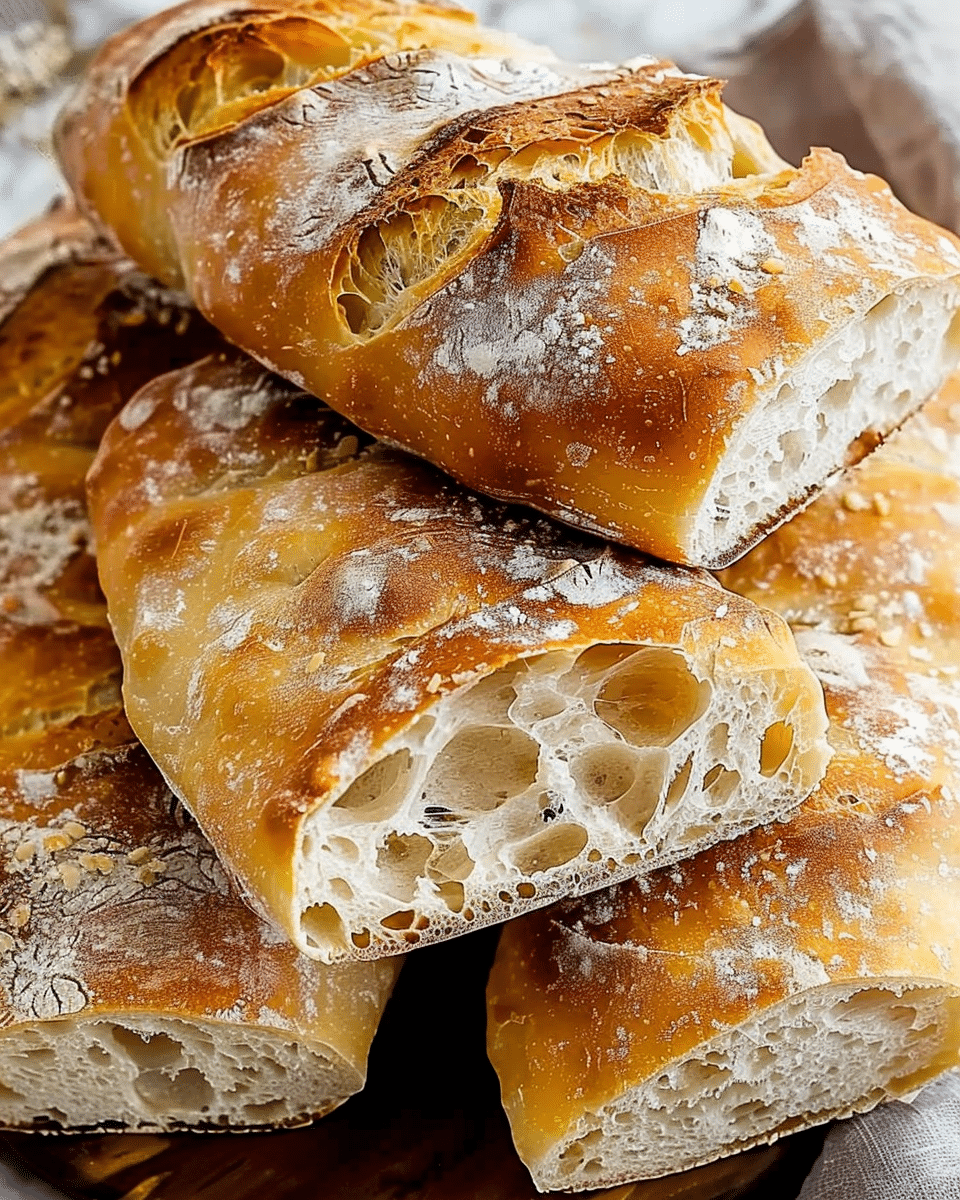
Ingredients
For the sponge:
-
50 grams (about ⅓ cup) all-purpose flour
-
2 grams (½ teaspoon) instant yeast (SAF is a great choice)
-
50 grams (about ¼ cup) water, lukewarm or room temperature
For the ciabatta dough:
-
360 grams (about 1.5 cups) water, lukewarm or room temperature
-
12 grams (about 2 teaspoons) salt, kosher or sea salt
-
450 grams (about 3.5 cups) bread flour
(Tip: You'll find the full list of ingredients and measurements in the recipe card below.)
Directions
-
Make the poolish: In a large bowl, whisk together the 50 grams of flour and the 2 grams of yeast. Add 50 grams of water and stir until combined. Cover with a tea towel and let it sit for 3 to 4 hours until the surface is dimpled with holes.
-
Make the dough: To the poolish, add the remaining water. The sponge should easily release from the bowl, with parts floating. Stir in the salt, then add the bread flour, stirring until the mixture forms a very sticky dough. Cover and let sit for 30 minutes.
-
Stretch and fold: Wet your hands and stretch one side of the dough, folding it into the center. Rotate the bowl a quarter turn and repeat the process. Continue until you’ve completed a full circle. If you have time, repeat the process 3 more times at 30-minute intervals for a total of 4 sets of stretches and folds. If you're short on time, one or two sets will suffice.
-
Let the dough rise: Transfer the dough to a straight-sided vessel or keep it in the bowl. Cover and let it rise until doubled in size. Deflate the dough by gently pressing down. Return it to the vessel, cover with an airtight lid, and refrigerate for at least 12 hours (up to 48 hours).
-
Portion and shape the dough: Turn the dough out onto a work surface (with or without flour, as preferred). Shape the dough into a tight ball, then divide it into two equal portions (roughly 455 grams each). Form each portion into a ball.
-
Proof the dough: Sprinkle flour on your countertop and place the dough balls seam-side up. Sprinkle more flour on top and cover with a tea towel. Let it proof for 2.5 hours. About 20 minutes before proofing is done, preheat your oven to 425°F.
-
Shape and bake: Line a sheet pan with parchment paper. After proofing, gently flip the dough balls over and stretch each into a rectangular shape. Transfer to the sheet pan and bake for 20-25 minutes, or until golden brown. Allow the ciabatta rolls to cool for 20 to 30 minutes on a cooling rack before slicing.
Servings and Timing
-
Yield: 8 ciabatta rolls (approximately)
-
Prep Time: 24 hours, including fermentation and proofing time
-
Cook Time: 20-25 minutes
-
Rest Time: 3-4 hours for poolish, 2.5 hours for proofing
-
Total Time: Around 24 hours and 20 minutes
Variations
-
Olive Ciabatta: Add chopped olives to the dough before the first set of stretches and folds for a Mediterranean twist.
-
Herb Ciabatta: Incorporate finely chopped fresh rosemary or thyme into the dough during the mixing stage for a fragrant, herby version.
-
Garlic Ciabatta: Mix in roasted garlic or garlic powder for an extra savory flavor.
-
Gluten-Free Ciabatta: Use a gluten-free all-purpose flour blend in place of regular bread flour for a gluten-free alternative, though the texture may differ slightly.
Storage/Reheating
Ciabatta bread is best enjoyed fresh, but if you have leftovers, you can store them at room temperature for up to 2 days. To keep the crust crispy, store the bread in a paper bag, not plastic. For longer storage, slice the bread and freeze it. Reheat slices in a toaster or wrap the whole loaf in foil and warm it in the oven at 350°F for 10 minutes.
FAQs
How can I make the dough less sticky?
If the dough is too sticky to handle, you can reduce the water by 50 grams. However, some stickiness is normal, as this is a high-hydration dough. Use a bench scraper to manage it better.
Can I use all-purpose flour instead of bread flour?
Yes, you can use all-purpose flour, but bread flour has more protein, which gives the ciabatta its structure and chewy texture.
How do I know when the dough has risen enough?
The dough should double in size during the rise. If you press it gently with your finger, the indentation should remain without springing back too quickly.
How long can I store the dough in the fridge?
The dough can be refrigerated for anywhere from 12 to 48 hours. The longer it rests, the more complex the flavor will be.
What can I use instead of a straight-sided vessel for rising the dough?
A large bowl works fine if you don’t have a straight-sided vessel. Just make sure to cover the bowl well to keep the dough from drying out.
Can I freeze the dough before baking?
Yes, you can freeze shaped and proofed dough balls. Let them thaw and come to room temperature before baking.
Why is my ciabatta dough so wet and sticky?
This is normal! Ciabatta dough has a high hydration rate, which contributes to its light, airy crumb and chewy texture.
Do I need a bench scraper for this recipe?
While not essential, a bench scraper helps in handling the wet dough, especially when shaping and dividing it.
Can I make this recipe without a stand mixer?
Yes, you can mix and knead the dough by hand, although it will require more effort. The dough should be very sticky and challenging to knead, but it will come together with a bit of patience.
Can I make ciabatta without the poolish?
The poolish helps develop flavor and texture, but if you don’t have time, you can skip it. The bread will still be delicious, though it may lack some of the depth that the preferment brings.
Conclusion
Homemade ciabatta bread is a labor of love that results in an irresistible loaf with a perfect blend of a crunchy crust and airy crumb. By following the steps carefully and being patient with the process, you'll be able to enjoy bakery-quality ciabatta rolls in your own kitchen. While it might take a little time, the end result is well worth the effort!
How To Make Fresh Homemade Ciabatta Bread
Ciabatta is a classic Italian bread known for its crispy crust and airy, open crumb. This recipe involves preparing a poolish (preferment), mixing and folding dough, and allowing it to rise and bake into fresh, homemade rolls.
- Prep Time: 24 hours, including fermentation and proofing time
- Cook Time: 20-25 minutes
- Total Time: Around 24 hours and 20 minutes
- Yield: 8 ciabatta rolls (approximately)
- Category: Bread
- Method: Baking
- Cuisine: Italian
- Diet: Vegetarian
Ingredients
50 grams (about ⅓ cup) all-purpose flour
2 grams (½ teaspoon) instant yeast
50 grams (about ¼ cup) water, lukewarm or room temperature
360 grams (about 1.5 cups) water, lukewarm or room temperature
12 grams (about 2 teaspoons) salt, kosher or sea salt
450 grams (about 3.5 cups) bread flour
Instructions
- Make the poolish: In a large bowl, whisk together the 50 grams of flour and the 2 grams of yeast. Add 50 grams of water and stir until combined. Cover with a tea towel and let it sit for 3 to 4 hours until the surface is dimpled with holes.
- Make the dough: To the poolish, add the remaining water. Stir in the salt, then add the bread flour, stirring until the mixture forms a very sticky dough. Cover and let sit for 30 minutes.
- Stretch and fold: Wet your hands and stretch one side of the dough, folding it into the center. Rotate the bowl a quarter turn and repeat the process. Continue until you’ve completed a full circle. Repeat the process 3 more times at 30-minute intervals for a total of 4 sets of stretches and folds.
- Let the dough rise: Transfer the dough to a straight-sided vessel or keep it in the bowl. Cover and let it rise until doubled in size. Deflate the dough by gently pressing down. Return it to the vessel, cover with an airtight lid, and refrigerate for at least 12 hours (up to 48 hours).
- Portion and shape the dough: Turn the dough out onto a work surface. Shape the dough into a tight ball, then divide it into two equal portions. Form each portion into a ball.
- Proof the dough: Sprinkle flour on your countertop and place the dough balls seam-side up. Sprinkle more flour on top and cover with a tea towel. Let it proof for 2.5 hours. Preheat your oven to 425°F about 20 minutes before proofing is done.
- Shape and bake: Line a sheet pan with parchment paper. After proofing, gently flip the dough balls over and stretch each into a rectangular shape. Transfer to the sheet pan and bake for 20-25 minutes, or until golden brown. Allow the ciabatta rolls to cool for 20 to 30 minutes on a cooling rack before slicing.
Notes
- To store, keep ciabatta bread in a paper bag for up to 2 days. For longer storage, slice and freeze it.
- If the dough is too sticky, reduce the water slightly.
- Try adding olives, rosemary, thyme, or garlic for flavor variations.
- This recipe can be made without a stand mixer, though kneading will be more labor-intensive.
- Poolish can be skipped, though it adds depth of flavor and texture to the bread.
Nutrition
- Serving Size: 1 roll
- Calories: 150
- Sugar: 1g
- Sodium: 300mg
- Fat: 1g
- Saturated Fat: 0g
- Unsaturated Fat: 1g
- Trans Fat: 0g
- Carbohydrates: 30g
- Fiber: 1g
- Protein: 5g
- Cholesterol: 0mg

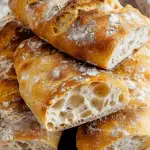
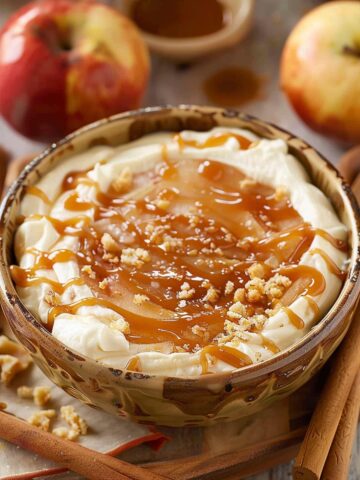
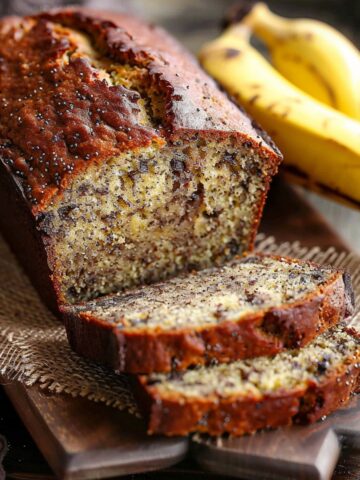


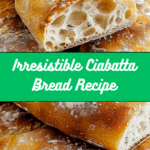
Leave a Reply